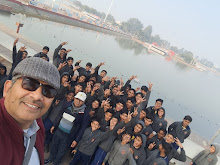SCHOOL
PLANS TO
"MAKE
A RECORD OF"
AND
" ORGANIZE ALUMNI
MEET"
FROM THE
YEAR 2001
ON
WARDS.
PLEASE GIVE
YOUR DETAILS IN "COMMENT" THE FORMAT PROVIDED IS..
1.YEAR
PASSED OUT/ ADMISSION NO -
2. NAME-
3. FATHERS/
MOTHERS NAME -
4. CLASS-
XIIA / XII B / XIIC
5. POSITION
/MARKS SECURED-
6. CURRENT
POSITION/ DESIGNATION-
7.
ORGANISATION WORKING WITH-
8. CORRESPONDENCE ADDRESS-
9. EMAIL
& MOB NO.
10. YOUR
VIEWS / COMMENTS ( 50 WORDS)
click to-
click to-
SOME OF THE TOPPERS OF
YEAR 2001 ARE....
1. MAST.
PRANV YADAV ( 80%) SCIENCE
2. MAST.
SURENDER SINGH ( 77.6%) HUMANITIES
3. MAST.
SHIV RAM KRISHN BALI (GOLD) ATHLETICS - 110 M HURDLE RACE
( CURRENT
DETAILS NOT AVAILABLE FOR ABOVE ALUMNI)
COORDINATOR ALUMNUS
FOR 2001
Dr. ANIL
YADAV
BDS
Dental Hospital and Maxillofacial Trauma Centre
SCO. 128-129
Brass Mkt.
REWARI
MOB. NO.
9416888775
E-mail-
dranilrao@yahoo.com
*ALUMNI-A group
of people who have graduated from a school or university.
Alumni is
usually used to refer to a group of graduates of either one or both genders,
while 'alumnus'
traditionally refers to a single male graduate,
with the
feminine term being 'alumna'.
List of students - 2001 Batch
Sl.
No.
|
Student’s Name
|
Father’s Name
|
1
|
Geeta Yadav
|
Sh. Vinod Yadav
|
2
|
Mamta Yadav
|
Sh. Babulal Yadav
|
3
|
Renu Yadav
|
Sh. Raghubir Singh
|
4
|
Rajisha
|
Sh. Vijay Singh
|
5
|
Sangeeta Yadav
|
Sh. Ved Prakash
|
6
|
Preeti
|
Sh. Bhawani Singh
|
7
|
Sunita
|
Sh. Om Prakash
|
8
|
Raj Bala
|
Sh. S.S. Yadav
|
9
|
Preetam Singh
|
Sh. Rampal Singh
|
10
|
Inderjit Singh
|
Sh. Deelip Singh
|
11
|
Kaptan Singh
|
Sh. Chhatarpal Singh
|
12
|
Satender Kumar
|
|
13
|
Satish Kumar
|
Sh. Rajender Singh
|
14
|
Bhuvan Kumar Yadav
|
Sh. Bhal Singh Yadav
|
15
|
Surender Singh
|
Sh. Mahabir Singh
|
16
|
Yogesh Yadav
|
Sh. Mohan Lal
|
17
|
Kamaljit
|
Sh. Balbir Singh
|
18
|
Parvinder Kumar
|
|
19
|
Kiran Yadav
|
Sh. Balwant Singh
|
20
|
Sonia
|
Sh. Jaipal Yadav
|
21
|
Madhusmita
|
Sh. Ramjas Sharma
|
22
|
Manju
|
|
23
|
Mithlesh Kumar Yadav
|
Sh. Maha Singh
|
24
|
Sarita Kumari
|
Sh Vijaypal Singh
|
25
|
Sheela
|
Sh. Lahiri Ram
|
26
|
Sonia
|
Sh. Satish Kumar
|
27
|
Kumari Sonu
|
Sh. Dayanand Yadav
|
28
|
Suman Kumari
|
Sh. Bijender Singh
|
29
|
Kiran Lata
|
Sh. Shambhu Dayal
|
30
|
Anil Kumar Yadav
|
Sh. Ram Kumar
|
31
|
Anil Yadav
|
|
32
|
Anil Yadav
|
Sh. Dharamvir Yadav
|
33
|
Ashwani Kumar
|
Sh. Sher Singh
|
34
|
Bhupender
|
Sh. Lalit Kumar
|
35
|
Govind Singh Yadav
|
Sh. Vijay Singh
|
36
|
Krishan Kumar
|
|
37
|
Manajyoti
|
Sh. Krishan Singh
|
38
|
Manoj Yadav
|
Sh. Lal Singh
|
39
|
Neetu Yadav
|
Sh. Mahender Singh
|
40
|
Pranav Yadav
|
Sh. Kanwar Singh
|
41
|
Rajkumar Singh
|
|
42
|
Sudarshan
|
|
43
|
Vijay Yadav
|






























